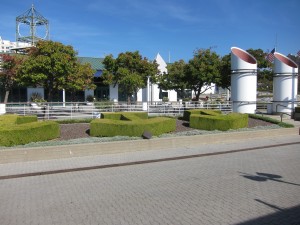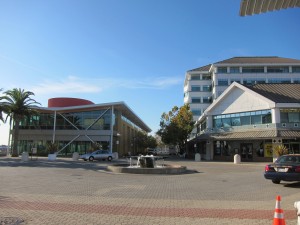As we mentioned in an earlier post, we docked Kosmos at South Beach Harbor Marina. We loved being in the heart of downtown. We could walk to many great restaurants and attractions. The marina entrance was steps from public transit that could easily and quickly take us anywhere beyond walking distance. The city was exciting and full of life, a fun place to be in general.
However, we didn’t love the marina. We were on an end tie, and it was a long walk to the boat from the gate — we estimate a full quarter mile. One of our friends commented that at night the dock was eerie — that it looked like the hallway from “The Shining.”
Our slip was exposed to the bay and very rocky — so much so that Christi had to leave the boat every afternoon when the wind picked up because she couldn’t take the rocking! There was no wireless Internet (well, technically there was but it was broken and the marina staff had no interest in fixing it), which made it tougher for Christi to write when she was onboard. The parking options were limited and ungodly expensive, making it challenging to have friends and family come over to visit. Laundry was also a problem. Because we were at the end, the electricity voltage was too low to run our washing machine. The marina’s washing machine had the hot and cold water set backwards, and of course, all cycles had a cold water final rinse, so all our delicate clothes took horrible beatings in the very hot rinse water. The marina staff seemed uninterested in fixing that problem, too, despite the fact it could have been resolved in literally five minutes.
After a month of spending every afternoon in Internet cafes unsuccessfully trying to work on the book (Christi is easily distracted by things going on around her; she really needs to write in isolation), Christi put her foot down and demanded that we move to another marina. Eric didn’t want to move, but realizing that it was useless to argue with a pregnant woman, he relented. With help and advice from our friends in the Bay area, we re-visited our options and decided Jack London Square Marina in Oakland was the best bet for Eric since it was close to both the ferry and the BART (train). Miraculously, they had space available.
On the morning of September 28, we untied the lines and headed east across the bay to the relatively narrow channel that separates Alameda Island from Oakland on the main land. The channel was a natural estuary that was widened and deepened in 1852 so that wharves could be built on the Oakland waterfront. In 1874, the channel was further dredged to make Oakland a deep water port. Over the years, they continued to deepen and widen the channel. In In 1962, Oakland became the first major port on the US Pacific Coast to have container ship terminals. Today the Port of Oakland is the fifth busiest container port in the United States.
We passed the container port. Though much smaller than many of the other container ports we’ve seen around the world (ie Singapore and Oman), it was still imposing. Jack London Square was not far beyond. We pulled into the small basin and were shocked to see the marina was virtually empty, with only a handful of boats. When we checked into the office we were told that a boat show had just ended two days prior. All the tenants had been kicked out for the show and most had not yet returned.
Right away, we were happy with the marina. Our slip was steps away from shore. The marina was protected from the main bay, and while the marina did get some occasional big rolls from the ferries and ships, it was relatively calm overall. Oakland is generally sunnier, warmer, and less windy than San Francisco, and we reveled in the warm afternoon sun as we tied up the lines.
Oakland is an area undergoing gentrification, and Jack London Square is one of the recently renovated areas. It is adorable! Once upon a time it was part of the industrial shipping area, but now it is a lively pedestrian area sporting a a variety of shops, restaurants, hotel and ferry terminal, along with the marina. Unfortunately, we didn’t take many photos of the square, but here are a couple shots.
The square is named after the famous American author Jack London, who grew up in Oakland near the waterfront and spent much of his youth working as a sailor and oyster pirate based out of what is now Jack London Square. London made notes for his books while sitting at Heinold’s First and Last Chance Saloon, built in 1883 from the timbers of a whaling ship. Heingold’s is still there, now a National Literary Landmark, that preserves the rustic character from the earlier era. It is an odd tiny wooden building with a few tables outside that stands out from the rest of the modern buildings surrounding it.
London eventually moved to Alaska. Interestingly enough, an adoring fan went to Alaska and found London’s log cabin. He had the cabin dismantled and brought back to California. The tiny cabin (the one here may only be a replica; the information about it is conflicting) sits in the middle of the square, next to Heingold’s bar.
This is part 7 of an 11 part series on our time in the San Francisco area. Read part 6 here and part 8 here.





Welcome to the Jack London District! I’ve had a boat over on the Alameda side of the estuary for many years and it is nice and sheltered and as you point out warmer and sunnier than SF on the whole. You just have to deal with the hour or so sail up the estuary to truly get out on the Bay. Still handy for getting the boat ready to sail or putting the sails away coming back. The ferry is a grand way to get to SF – probably the best commute in the Bay Area.